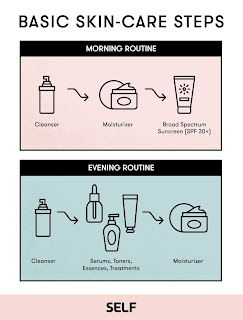How to Build an Extended Routine
- Get link
- X
- Other Apps
Hi again! Previously, I talked through how to build a basic routine so now I will go into an extended routine. By extended, I mean adding extra products that are not necessarily essential like toners, serums, masks (sheet, clay, chemical peels, etc), eye cream, spot treatments, facial oils and mists, and more. The range of skincare products is very broad so I’ll stick to the general ones.
Toners
Applied after cleansing, this step can have different purposes but a similar goal is to balance the pH levels after cleansing. These tend to have a lighter, fluid texture and viscosity. A variety of toners include hydrating, exfoliating, treatment.
Hydrating
toners would best match the aim of balancing pH levels, while also
replacing the moisture lost from cleansing.
Chemical exfoliating
toners are a gentle alternative to
physical scrubs or peels to remove dead skin cells. They work on both the top
layer and inner, deeper levels. The main groups of chemical exfoliants are AHA
(alpha hydroxy
acid) and BHA
(beta hydroxy acid), with PHA (poly hydroxy acid), and LHA (lipo
hydroxy acid), being a gentler
version of the latter.
Treatment toners are similar to serums; they have specific ingredients that target certain skin concerns e.g. acne, brightening, anti-aging.
Tip: pour the toner into your palms and apply with your hands in a gentle manner to save cotton pads. You may use cotton pads for exfoliating toners instead.
Essences/Serums/Ampoules
Usually applied after cleansing and before moisturising. Its purpose is to target a specific skin concern, typically using a concentrated number of ingredient(s) to treat e.g. acne, brightening, anti-aging, dull and uneven skin. The difference between the three is mainly the concentration, from essences (lower concentration) to serums, then to ampoules (higher concentration). The texture depends on the formulation – some may be more watery and some, more viscous but it won’t be solid per se like a cream.
Tip: if it comes in a dropper bottle, DO NOT let that dropper touch your face and never touch it (because of germs and bacteria). Instead, drop it down from some height onto your face or drop it into your palm before applying with your hands.
Masks (sheet, wash-off, sleeping)
There are a variety of types
of masks including sheet masks, wash-off masks, sleeping masks, and I would actually put chemical
peels here too. These are used after cleansing.
Sheet masks are face-shaped sheets that are made of fibre, cotton,
hydrogel, etc that are soaked in serum for an intensive delivery of the masks’
ingredients to the skin. You may apply toner before using a sheet mask if you
wish. Always follow up with moisturiser to seal it off, please don't wash your face. 😣
Wash-off masks – purpose and benefits of it varies, similar to sheet
masks e.g. provides hydration, brightening, etc but with the added step of washing
it off. For example, clay masks, as the name suggests, are formulated
clay that you apply, wait to dry up (for about 10-15 minutes depending on the product
instructions), and then rinse off. This is used as a deep cleansing step and
help to draw impurities and sebum from your pores. It is similar to chemical
peels/peeling gel where it works as an exfoliator that removes layers of your
skin so that new layers are formed. Other masks can be hydrating or calming e.g. honey mask, mugwort mask.
Sleeping masks are like an additional layer of moisturiser on top of your existing one to give your skin more protection and moisture through the night. These are particularly good for drier skin types.
Tip: use excess product in sheet masks on your neck, décolleté, arms - everywhere!
What do you think of these
products? Do you think they are necessary and would you consider using them? Of
course, it depends on your preference and what your skin needs so don’t feel
like you need to be using all of these! After all, less is more ;)
- Get link
- X
- Other Apps




Comments
Post a Comment